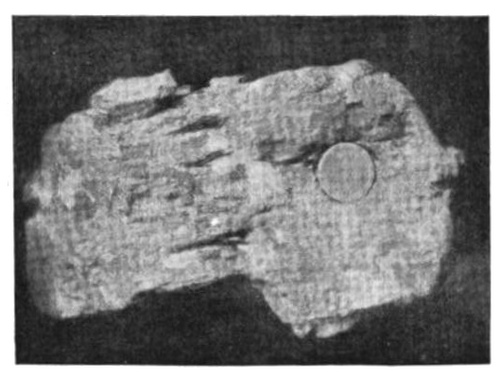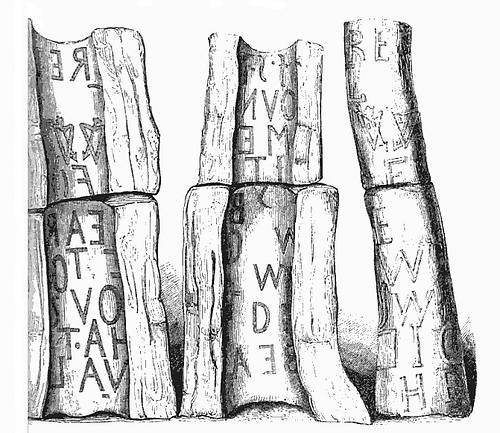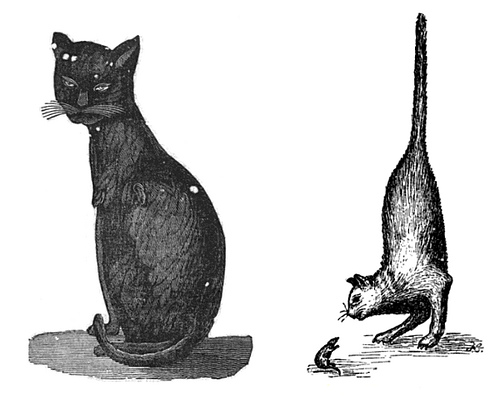
From The Strand, April 1901. R.C. Hardman of Meadhurst, Uppingham, ordered a ton of coal and found a coin dated 1397 embedded in one lump.
If there’s an explanation for this, I can’t find it.

From The Strand, April 1901. R.C. Hardman of Meadhurst, Uppingham, ordered a ton of coal and found a coin dated 1397 embedded in one lump.
If there’s an explanation for this, I can’t find it.

Some kings expire in bed. Some die gloriously in battle.
Alexander of Greece was bitten to death by monkeys.
He was walking in the royal garden in October 1920 when a monkey attacked his dog. He fought it off with a stick, suffering only a wound on the hand, but the monkey’s mate rushed in and gave him a much more severe bite. He died of blood poisoning three weeks later.
Alexander’s exiled father returned and led the nation into a bloody war with Turkey. “It is perhaps no exaggeration,” wrote Winston Churchill, “to remark that a quarter of a million persons died of this monkey’s bite.”

He was hatched near Birmingham, purchased in the market of Alcester, in the county of Warwick, and is now the property of Mr. John Weisman, tailor, residing at No. 6, Lombard Street, Mint Street, Southwark. … He is strongly made, his plumage beautifully variegated and spangled, and of a fine tone of colour. When seen in front he appears to resemble any other animal of the same species, except that his beak is small for his size, and his comb and wattles are considerably larger than usual: but connected with the rump there is a smaller body, which is provided with a second pair of legs, with spurs equal in size to those of the other legs, being three inches in length and remarkably strong. These hinder legs the animal does not employ in walking; they hang down behind the others, not loosely, but on the contrary, in a firm and strong manner. He has two vents which he uses indiscriminately; and crows both loud and well.
– Kirby’s Wonderful and Scientific Museum, 1820

A very singular discovery of an inscription was made some time since at Coxwold, near Thirsk in Yorkshire. … An ash was … felled and split for firewood. Upon being riven asunder, the outer part of the tree was cleft in two like a case, leaving the inner portion of the trunk entire, and the following rude inscription was discovered, distinctly legible, both upon the inner part of the trunk, and with the letters inverted, upon the outer casing. The inscription can, without difficulty, be thus read:–
There is no date to the inscription, but … it would … appear that the tree has been cut down nearly a hundred years. Also, by the number of rings in the wood, each indicating a year’s growth, the tree appears to have been about fifty-five years old when the inscription was made, and to have subsequently grown for nearly two hundred years. The closeness of the rings under the circumference prevents this estimation of the date from being regarded as more than an approximation; but all the circumstances render it highly probable that the inscription was made about three centuries ago.
– Kazlitt Arvine, Cyclopaedia of Anecdotes of Literature and the Fine Arts, 1856
Harvard anthropologist Terrence Deacon was walking past the New England Aquarium one day in 1984 when a voice yelled, “Hey! Hey! Get outta there!”
He stopped, but saw no one. Again the voice said, “Hey! Hey you!” Eventually he traced it to an enclosure of harbor seals, and to one in particular that seemed to be speaking English:
On investigating, Deacon learned that “Hoover” (named for his appetite) had been discovered as a pup by a Maine fisherman and donated to the aquarium, where he became a star attraction.
Deacon studied the seal for a year. Regarding the vocalizing, he notes that some birds seem to learn their parents’ songs in early life but sing them only later. “Though we will never know for sure,” he writes, “the image of Hoover guzzling the food in the cupboard and the old fisherman yelling, ‘Hey! Hey! Hoover! Hey you! Get outta there!’ has a persuasive feel, or twisted irony.”
William Beckford’s 1835 travel memoir Italy: With Sketches of Spain and Portugal contains a startling episode in the monastery El Escorial, near Madrid:
Forth stalked the prior, and drawing out from a remarkably large cabinet an equally capacious sliding shelf–(the source, I conjecture, of the potent odour I complained of)–displayed lying stretched out upon a quilted silken mattress, the most glorious specimen of plumage ever beheld in terrestrial regions–a feather from the wing of the Archangel Gabriel, full three feet long, and of a blushing hue more soft and delicate than that of the loveliest rose. I longed to ask at what precise moment this treasure beyond price had been dropped–whether from the air–on the open ground, or within the walls of the humble tenement at Nazareth; but I repressed all questions of an indiscreet tendency–the why and wherefore, the when and how, for what and to whom such a palpable manifestation of archangelic beauty and wingedness had been vouchsafed.
It should be noted that Beckford was something of an eccentric; his enormous country house had collapsed 10 years earlier, and perhaps his writings too were built on dreams. But the monks aren’t telling.
One day last week a marvelous apparition was seen near Coney Island. At the height of at least a thousand feet in the air a strange object was in the act of flying toward the New Jersey coast. It was apparently a man with bat’s wings and improved frog’s legs. The face of the man could be distinctly seen, and it wore a cruel and determined expression. The movements made by the object closely resembled those of a frog in the act of swimming with his hind legs and flying with his front legs. … When we add that this monster waved his wings in answer to the whistle of a locomotive, and was of a deep black color, the alarming nature of the apparition can be imagined. The object was seen by many reputable persons, and they all agree that it was a man engaged in flying toward New Jersey.
– New York Times, Sept. 12, 1880
Sir:–Among many strange coincidences which I have experienced in my time, one of the most singular which I can recall at the moment happened to me in connection with a play which I wrote some twenty years ago for the German Reed entertainment. One of my characters was named Robert Golding, and for the requirements of the plot I had made him the sole survivor of the crew of a ship called the Caroline, which had been lost at sea. A few days after the production of the play I read in a newspaper an account of the shipwreck of a vessel named the Caroline, which had gone down with all hands, with one exception, and this exception was a man of the name of Golding. Now Golding is not at all a common name, and the circumstance of his being, both in fact and fiction, the sole survivor of the shipwrecked Caroline, impressed me at the time as being a coincidence of a very peculiar nature. Yours faithfully, ARTHUR LAW.
– London Daily Graphic, Sept. 7, 1905, quoted in Experiments in Psychical Research at Leland Stanford Junior University, 1917

The cat on the left appeared in Nathaniel Hawthorne’s American Magazine of Useful and Entertaining Knowledge in October 1836. It’s difficult to tell from the drawing, but I think she’s missing her left front and right rear legs. “She was active, and would leap on a table, to the height three or four feet. Her gait is odd, as might be supposed, and often she leaps like a frog. … She frequently sits in the posture as given in the annexed drawing, especially when expecting to receive food; and her appearance very singular and rather ludicrous. Though destitute of claws, she is a good mouse-catcher. The tail is usually extended, and then she resembles somewhat that singular animal, the kangaroo.”
The other was featured in Arthur’s Home Magazine in July 1891, “a most cheerful, healthy, engaging little creature” whose “fashion of walking was queer, but lively.” She belonged to F.C. Hill, a professor at Princeton, who returned from a two-week trip in spring 1877 to find her dead. “Poor kitty was well and happy while I was with her,” he wrote. “I really think she pined and died as much from loneliness as anything else.” Her skeleton was displayed in the museum at Princeton College, “so that pussy remains as serviceable after death as it was her warm will to be in life.”
Out in Cheatham county about noon on Wednesday — a remarkably hot day — on the farm of Ed. Sharp, five miles from Ashland, a sort of whirlwind came along over the neighbouring woods, taking up small branches and leaves of trees and burning them in a sort of flaming cylinder that travelled at the rate of about five miles an hour, developing size as it travelled. It passed directly over the spot where a team of horses were feeding and singed their manes and tails up to the roots; it then swept towards the house, taking a stack of hay in its course. It seemed to increase in heat as it went, and by the time it reached the house it immediately fired the shingles from end to end of the building, so that in ten minutes the whole dwelling was wrapped in flames. The tall column of travelling caloric then continued its course over a wheat field that had been recently cradled, setting fire to all the stacks that happened to be in its course. Passing from the field, its path lay over a stretch of woods which reached the river. The green leaves on the trees were crisped to a cinder for a breadth of 20 yards, in a straight line to the Cumberland. When the ‘pillar of fire’ reached the water, it suddenly changed its route down the river, raising a column of steam which went up to the clouds for about half-a-mile, when it finally died out. Not less than 200 people witnessed this strangest of strange phenomena, and all of them tell substantially the same story about it. The farmer, Sharp, was left houseless by the devouring element, and his two horses were so affected that no good is expected to be got out of them in future. Several withered trees in the woods through which it passed were set on fire, and continue burning still.
– Nashville, Tenn., Press, quoted in Symons’s Monthly Meteorological Magazine, September 1869